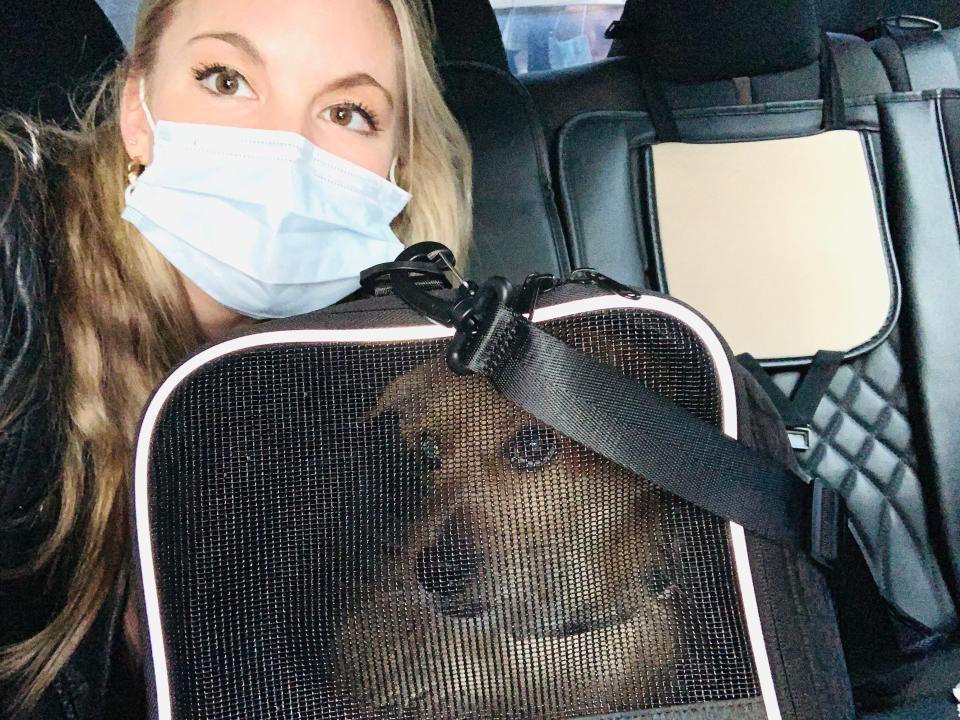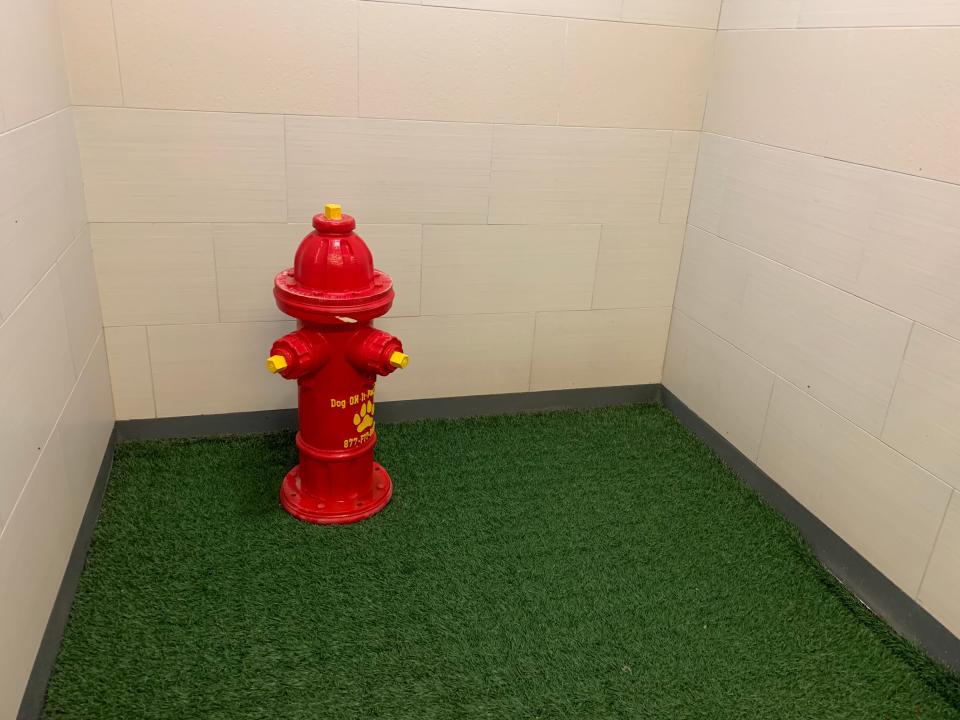Traveling with your pet for the first time? Here are tips from my flight with a dog
We've all seen dogs at the airports with their owners. Usually, I'm jealous. I adore dogs. But flying from Newark, New Jersey, to Florida, for Thanksgiving with my foster dog, Bono, I experienced the dogs-in-the-airport cuteness from a different perspective.
Bono, who is 2 years old and weighs about 15 pounds, was traveling with my partner and me on a United Airlines flight bound for Florida for Thanksgiving where he would be introduced to his new family and forever home.
Almost a month before, we had fostered him from an organization based in New York City. When my boyfriend's parents agreed to adopt him, we were thrilled. We thought, "perfect, we're going to Florida at the end of the month for the holiday anyway, he can just fly down with us."
I envisioned shopping for a cute carrier like I'd seen at the vet's office and giving him a few pets as we walked through the airport.
Let me tell you, it was not exactly a breeze.
What didn't exist in my pet-travel imagining was airline requirements, extra costs and other parts of travel such as getting to the airport.

Preparing to fly: Check the airline's website for requirements; ask a vet
The week before we flew, we started wondering about the requirements to fly with a dog. For the record, this is something to think about much earlier if you're planning to fly with a dog. But the decision for Mike's parents to adopt Bono was not made until just a couple weeks before we were set to fly.
• Check the airline's requirements for flying with a pet.
We looked up policies on United for traveling with in-cabin pets. There was a $125 service fee each way to board with a pet. We flew with him one way, so it cost an additional $125 on top of our tickets.
While the cost was clear cut, we ran into a problem with United trying to determine what kind of health certificate Bono might need. Over multiple calls and online chats with customer service, we received different answers on what he would need: a certificate from the vet within a certain period of flying (which would have required another vet visit), a certificate from our previous visit in November (which would have cost money to obtain as well) or no certificate at all.
In the end, a customer service representative made a note on our reservation that we did not need a health certificate provided by a vet for Bono to prove he was fit to fly. We made sure to have his vaccination records ready for TSA in case they might be needed, just in case.
According to the American Veterinary Medical Association, a health certificate is often required when traveling over state and international borders and must be signed by an accredited vet to prove your dog is free of infectious diseases and meets other health standards depending on where you are traveling.
• For dogs flying in-cabin, purchase or use a carrier.
We also knew he needed a carrier, which was a difference from a train trip we took him on to Connecticut earlier in the month.(Dogs aren't required to be in carriers on Metro North commuter trains.) So, we ordered a carrier on Amazon. Unfortunately, we later discovered we accidentally ordered a carrier that was too large according to United's policy. We ordered the right size that arrived the day before we were set to leave, thankfully.
• Practice with your pet ahead of flying.
Before flying with Bono, we practiced spending time in his carrier, placing it on his favorite area of the couch and putting treats inside. He didn't love it at first but eventually entered on his own. I also practiced carrying him in it around our apartment after he seemed to have settled in on his own.
• Still nervous? Ask a vet.
Before leaving the Tuesday before Thanksgiving, I was still nervous. Bono was OK with being in his carrier for short periods. But after a while, he definitely seemed to feel confined – after waking from a nap, for example, he tried to dig his way out of his carrier.
Worried that he'd be uncomfortable or antsy, I called a vet that we had seen earlier in the month. We'd already spent some time on the phone with them while determining whether we'd need a health certificate for Bono to fly. When I shared that Bono seemed anxious, a representative told us we could give him one half a Benadryl to help him rest during the flight to be administered before leaving the apartment.
• Take your dog out before leaving.
Looking at total travel time in advance, we knew Bono would have to spend the next several hours in his carrier, so wanted to make sure that he had been out beforehand to expend some energy and use the bathroom.
• Make sure, if you're taking an Uber or Lyft, that your driver is OK with an animal in the car.
If you're taking a ride-hailing service, make sure to check to see if your driver is ready for a pet in the car. Uber's app has an option, when selecting the kind of ride you wish to request for riding with your pet, something we realized later. However, we did call our driver ahead of their arrival to check if they were OK with a dog in the car.

What to do at the airport, in flight with your dog
At the airport, we felt like we had already made it through some of the more stressful parts of the trip. We were on our way.

• Be prepared to take your dog out of its carrier for security.
My partner, Mike, took Bono through TSA PreCheck with him. I, unfortunately, do not have PreCheck and found myself waiting on a much longer line.
Going through security was relatively easy, he said. Mike took Bono out of the carrier, which went through the X-ray machine, and carried him through the metal detector. It took just an extra minute – they actually made it through security just before I did.
• Find an animal relief area.
At the airport, we wanted to make sure Bono had the chance to use the bathroom if he wanted to. After going through TSA, since the ride to the airport took an hour or so thanks to traffic, we went to find an animal relief area.
We found a "Service Animal Relief Area" in the terminal. Because it was for service animals and Bono isn't one, we wanted to make sure it was OK for him to use it, too. After getting the OK from a nearby employee, he sniffed around a bit but opted to hold off.

That said, it was nice to know there was a place to bring him should he need to go.
• On the plane, petting and treats are helpful.
Bono spent the better part of the flight trying to dig out of his crate. Before takeoff, we spent time petting him and that seemed to help. We also gave him a few treats. He decided he was fine with the situation right before landing (of course).
When we landed, I was relieved. I was happy that we were able to take Bono on the flight, but the situation felt stressful for him and for us. Next time, I would begin to prepare much earlier and make sure I am clear on the airline policies before booking.
Have you flown with your pet recently? Tell us about your experience! Email mhines@usatoday.com to share your story.
This article originally appeared on USA TODAY: Dog travel: Taking a pet on a plane for the first time? Here are tips

 Yahoo Movies
Yahoo Movies 